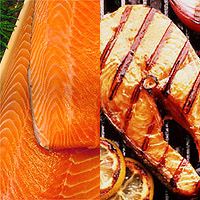Search Healthnotes
Salmon

Varieties
There are five types of Pacific salmon. Chinook, also called the spring or king salmon, often weighs in at more than 35 pounds (15.75 kg); prized by gourmets, its firm flesh can range from ivory white to deep red. Chum salmon (also known as dog salmon) are known as keta when canned; the flesh ranges from pale to medium red. Coho, or silver salmon, is known for its red color and its versatility. Sockeye is the mainstay of the commercial fish industry; it has a deep red-orange, firm flesh, and is called “red salmon” when canned. Lastly, Pink salmon (also known as humpback or humpie) are the smallest and most abundant of the Pacific species; the flesh is light in color and delicately flavored.
Atlantic salmon, native to Nova Scotia and Norway, is usually farm-raised in the United States.
Copyright © 2025 TraceGains, Inc. All rights reserved.
Learn more about TraceGains, the company.
The information presented in the Food Guide is for informational purposes only and was created by a team of US–registered dietitians and food experts. Consult your doctor, practitioner, and/or pharmacist for any health problem and before using any supplements, making dietary changes, or before making any changes in prescribed medications. Information expires December 2025.











